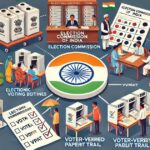In this blog post we are discussing Local Self Government in India: Control, Limitations, and Challenges, India refers to the system of governance at the grassroots level, where citizens participate directly or indirectly in decision-making processes that affect their local communities. The concept is enshrined in the Constitution of India under the provisions of the Panchayati Raj institutions for rural areas and Municipalities for urban areas.
In rural areas, the foundation of local self-government lies in the Gram Panchayats, which are elected bodies representing villages or groups of villages. These Gram Panchayats form the base level of the three-tier system of Panchayati Raj, followed by Panchayat Samitis at the intermediate level and Zila Parishads at the district level.
Similarly, in urban areas, Municipalities play a crucial role in local governance. Municipal bodies are responsible for providing essential civic services such as water supply, sanitation, roads, and waste management.
The essence of local self-government lies in decentralization, where powers and responsibilities are delegated to the local level to ensure effective and efficient administration. This decentralized structure aims to empower communities, promote local development, and enhance citizen participation in governance processes.
Importance of Local Governance in a Democratic Setup:

Local governance is the cornerstone of a vibrant democracy as it fosters active citizen engagement and accountability. Here are several reasons highlighting the importance of local governance:
1. Proximity to the People:
Local governments are closest to the citizens, enabling them to understand the unique needs and challenges of the local community better.
This proximity facilitates responsive decision-making and tailored solutions to address local issues effectively.
2. Enhanced Participation:
Local self-government encourages citizen participation in democratic processes.
It provides opportunities for individuals to actively engage in decision-making, express their opinions, and contribute to community development initiatives.
3. Accountability and Transparency:
By decentralizing power, local governance promotes accountability and transparency in administration.
Elected representatives are directly accountable to the local populace, fostering greater trust and integrity in governance.
4. Promotion of Social Justice:
Local self-government plays a crucial role in promoting social justice and inclusivity by empowering marginalized communities and ensuring their representation in decision-making bodies.
It facilitates equitable distribution of resources and opportunities, thereby reducing disparities and fostering social cohesion.
5. Efficient Service Delivery:
Local governments are better equipped to understand the specific needs of their communities and deliver essential services efficiently.
Decentralization leads to quicker response times, improved service quality, and better resource allocation, ultimately enhancing the overall quality of life for citizens.
In essence, local governance strengthens the foundations of democracy by empowering citizens, promoting participatory democracy, and fostering inclusive development at the grassroots level.
It serves as a vital link between the government and the people, driving socio-economic progress and fostering a sense of ownership and belonging within local communities.
Structure of Local Self Government in India: Control, Limitations, and Challenges
Explanation of the Three-Tier System: Rural and Urban Local Bodies

Rural Local Bodies:
1. Gram Panchayat:
At the base level of the rural local governance structure is the Gram Panchayat, which represents a village or a group of villages.
Gram Panchayats are composed of elected representatives known as Panchayat members, headed by a Sarpanch or Gram Pradhan.
The primary responsibilities of Gram Panchayats include:
Providing basic civic amenities such as water supply, sanitation, and street lighting.
Implementation of rural development schemes and poverty alleviation programs.
Maintenance of local infrastructure including roads, schools, and community centers.
Gram Panchayats play a crucial role in grassroots-level administration and decision-making, addressing the specific needs and priorities of rural communities.
2. Panchayat Samiti (Intermediate Level):
Panchayat Samiti, also known as Block or Taluka Panchayat, operates at the intermediate level between Gram Panchayats and Zila Parishads.
Panchayat Samitis are comprised of elected representatives from various Gram Panchayats within a designated block or taluka.
The key functions of Panchayat Samitis include:
Coordination and supervision of development activities at the block level.
Planning and implementation of welfare schemes and development projects.
Facilitation of resource mobilization and allocation for local development initiatives.
Panchayat Samitis act as a link between the grassroots-level administration of Gram Panchayats and the district-level governance provided by Zila Parishads.
3. Zila Parishad (District Level):
Zila Parishad, or District Council, is the apex body of rural local governance operating at the district level.
Zila Parishads comprise elected representatives from Panchayat Samitis as well as members nominated by the state government.
The primary responsibilities of Zila Parishads include:
Planning and coordination of development activities at the district level.
Allocation of funds and resources for various development projects and schemes.
Oversight of the functioning of Gram Panchayats and Panchayat Samitis within the district.
Zila Parishads play a crucial role in district-level administration, ensuring effective implementation of rural development policies and programs.
Urban Local Bodies:

1. Municipal Corporation:
Municipal Corporations are the highest tier of urban local governance and are responsible for large cities and urban agglomerations.
Municipal Corporations are headed by a Mayor or Municipal Commissioner and consist of elected councilors representing different wards or constituencies.
The key functions of Municipal Corporations include:
Provision of urban infrastructure and civic amenities such as water supply, sanitation, roads, and solid waste management.
Urban planning and development including land use regulation and building permissions.
Revenue generation through taxes, fees, and other sources to fund municipal services and projects.
Municipal Corporations play a pivotal role in managing the complexities of urban governance and ensuring the sustainable development of cities.
2. Municipal Council/Nagar Panchayat:
Municipal Councils, also known as Nagar Palikas or Nagar Panchayats, cater to smaller urban areas and towns.
Municipal Councils are governed by elected councilors headed by a Chairperson or President.
The functions of Municipal Councils are similar to Municipal Corporations and include providing essential urban services, infrastructure development, and local governance.
Municipal Councils play a vital role in addressing the urbanization challenges faced by smaller towns and peri-urban areas, promoting inclusive growth and development.
3. Roles and Responsibilities of Each Tier:
Gram Panchayat:
Responsible for grassroots-level administration, provision of basic services, and local development in rural areas.
Panchayat Samiti:
Acts as an intermediary between Gram Panchayats and Zila Parishads, coordinating development activities at the block level and facilitating resource mobilization.
Zila Parishad:
Provides district-level governance, planning, and coordination of rural development activities, and oversees the functioning of Gram Panchayats and Panchayat Samitis within the district.
Municipal Corporation:
Manages urban governance in large cities, providing a wide range of municipal services, infrastructure development, and urban planning.
Municipal Council/Nagar Panchayat:
Addresses the needs of smaller urban areas and towns, providing essential urban services, infrastructure development, and local governance.
Control Mechanisms in Local Self-Government in India

Control mechanisms in local self-government in India are established to ensure accountability, transparency, and effective functioning of local bodies. These mechanisms encompass constitutional provisions, administrative control, financial oversight, electoral regulations, and accountability mechanisms. Let’s delve into each aspect in detail:
1. Constitutional Provisions:
The Constitution of India contains provisions (Part IX and IX-A) that define the framework for local self-government in rural and urban areas.
These provisions outline the composition, powers, and functions of Panchayats and Municipalities, ensuring their constitutional status and autonomy in local governance.
2. Administrative Control:
Administrative control over local bodies is exercised by the state government through various administrative mechanisms.
State governments appoint District Collectors or District Magistrates who serve as the principal representatives of the state government at the district level and oversee the functioning of local bodies.
Administrative departments at the state level provide guidance, supervision, and support to local bodies in implementing government policies and programs.
3. Financial Control:
Financial control over local bodies is exerted through budgetary allocations, financial regulations, and audit mechanisms.
State governments provide funds to local bodies through grants-in-aid, state finance commissions, and centrally sponsored schemes.
Local bodies are required to prepare annual budgets, maintain financial records, and undergo periodic audits to ensure transparency and accountability in financial management.
4. Election Commission Oversight:
The Election Commission of India oversees the conduct of elections to Panchayats and Municipalities to ensure free, fair, and transparent electoral processes.
The commission is responsible for delimitation of constituencies, preparation of electoral rolls, and conduct of elections in accordance with electoral laws and regulations.
5. Finance Commission Oversight:
The Finance Commission of India is tasked with recommending the distribution of financial resources between the central and state governments as well as between the state government and local bodies.
State finance commissions are constituted to recommend the distribution of financial resources among Panchayats and Municipalities within the state based on principles of equity, efficiency, and fiscal autonomy.
6. Judicial Review:
Judicial review serves as a mechanism for enforcing constitutional provisions and safeguarding the rights of citizens.
Local bodies and their decisions can be subject to judicial scrutiny to ensure compliance with constitutional principles, statutory provisions, and procedural fairness.
7. Accountability Mechanisms:
Local bodies are accountable to the electorate through regular elections and democratic processes.
Mechanisms such as Gram Sabhas (in rural areas) and Ward Committees (in urban areas) provide platforms for citizen participation, feedback, and oversight.
Local bodies are required to maintain transparency in decision-making, publicize their activities, and respond to grievances and complaints from citizens.
8. Ombudsman Institutions:
Some states have established Ombudsman institutions or Lokayuktas to investigate allegations of corruption, maladministration, and misconduct in local governance.
Ombudsman institutions serve as independent watchdogs to ensure accountability and integrity in the functioning of local bodies.
9. Performance Evaluation:
Performance evaluation mechanisms, such as performance audits and evaluations, are conducted to assess the effectiveness, efficiency, and impact of local bodies in delivering services and achieving developmental objectives.
Benchmarking, indicators, and targets are used to measure the performance of local bodies and identify areas for improvement.
10. Central and State Government Control over Local Bodies:
While local bodies enjoy constitutional recognition and autonomy, they are subject to the overarching authority of the central and state governments.
Central and state governments exercise control through legislative enactments, executive orders, and policy directives.
Local bodies are required to adhere to laws, rules, and regulations promulgated by the central and state governments in matters such as planning, taxation, land use, and public service delivery.
11. Legislative Framework Governing Local Self-Government:
The legislative framework governing local self-government comprises laws enacted by central and state legislatures, including the Constitution of India, Panchayati Raj Acts, Municipal Acts, and other relevant statutes.
These laws define the powers, functions, structure, and procedures of local bodies, as well as the rights and obligations of elected representatives, officials, and citizens.
Limitations of Local Self-Government in India:

1. Financial Constraints and Dependence on Higher Authorities:
Local self-government bodies in India often face significant financial constraints due to inadequate revenue sources and heavy dependence on grants from higher authorities, such as the central and state governments.
Limited revenue-raising powers restrict the autonomy of local bodies in budgetary planning and resource allocation, constraining their ability to address local development priorities effectively.
Unequal distribution of financial resources among different tiers of government exacerbates disparities in service delivery and infrastructure development across regions.
2. Lack of Administrative Autonomy:
Despite constitutional provisions granting autonomy to local bodies, they often lack sufficient administrative powers to execute their functions independently.
Administrative decisions and policies are frequently influenced or overridden by higher authorities, leading to bureaucratic interference and inefficiencies in local governance.
The absence of administrative autonomy undermines the accountability and responsiveness of local bodies to local needs and preferences, hindering effective service delivery and development outcomes.
3. Challenges in Implementing Decisions at the Grassroots Level:
Local self-government bodies encounter challenges in implementing decisions and programs effectively at the grassroots level due to various factors, including inadequate infrastructure, human resource constraints, and capacity limitations.
Limited technical expertise and administrative capacity hinder the planning, execution, and monitoring of development projects and welfare schemes at the local level.
Socio-political factors such as caste dynamics, vested interests, and political interference further complicate decision-making processes and implementation efforts, impeding the realization of local development objectives and inclusive governance.
4. Limited Autonomy:
Despite being constitutionally recognized, local self-government bodies in India often lack true autonomy. Their powers, functions, and finances are subject to control by state governments, which can restrict their decision-making authority.
This limitation undermines the principle of decentralization and hampers the ability of local bodies to address local needs effectively.
1. Dependency on State Governments:
Local bodies depend heavily on state governments for financial resources, as they have limited revenue-raising powers.
This dependency makes them vulnerable to political interference and manipulation by state authorities, impacting their ability to implement local development projects and initiatives autonomously.
2. Inadequate Financial Resources:
Local self-government bodies in India often face financial constraints due to inadequate devolution of funds from higher levels of government.
They rely heavily on grants and allocations from the state and central governments, which may not be sufficient to meet the growing demands for local infrastructure, services, and development projects.
3. Unequal Resource Distribution:
Resource distribution among local bodies in India is often unequal, with urban areas receiving more funding and resources compared to rural areas.
This disparity exacerbates existing socio-economic inequalities and undermines the principle of equitable development. Rural and marginalized communities often lack access to basic amenities and services due to limited resources.
4. Limited Capacity and Expertise:
Many local self-government bodies in India lack the necessary capacity, expertise, and technical know-how to plan and implement development projects effectively.
They often struggle with administrative inefficiencies, bureaucratic red tape, and a shortage of skilled personnel, which hinder their ability to deliver quality services and infrastructure to citizens.
5. Political Interference and Corruption:
Local self-government bodies in India are susceptible to political interference, corruption, and nepotism. Politicians and bureaucrats may manipulate local institutions for personal gain or political advantage, undermining the integrity and credibility of local governance.
Corruption and malpractice erode public trust in local bodies and impede their ability to serve the interests of citizens effectively.
6. Weak Legal Framework:
The legal framework governing local self-government in India is often fragmented, complex, and outdated.
There is a lack of clarity in roles, responsibilities, and jurisdiction between different tiers of government, leading to confusion and inefficiencies in governance.
The absence of comprehensive legislation and regulatory mechanisms further complicates the functioning of local bodies.
7. Limited Citizen Participation:
Despite efforts to promote decentralization and citizen participation, grassroots democracy remains weak in many parts of India.
Local self-government bodies often face challenges in engaging citizens and fostering active participation in decision-making processes.
Factors such as illiteracy, socio-economic disparities, and cultural barriers inhibit meaningful participation by marginalized communities, limiting the inclusiveness and effectiveness of local governance.
8. Infrastructure and Technological Constraints:
Many local self-government bodies in India lack adequate infrastructure and technological resources to streamline administrative processes and service delivery.
Outdated systems, inadequate connectivity, and limited access to information and communication technologies hinder the digital transformation of local governance, making it difficult to meet the evolving needs of citizens in the digital age.
9. Vulnerability to External Influences:
Local self-government bodies in India are vulnerable to external influences, including pressure from interest groups, businesses, and non-governmental organizations (NGOs).
These external actors may exert undue influence on decision-making processes, shaping policies and priorities in ways that may not necessarily align with the interests of local communities.
Such influences undermine the autonomy and independence of local bodies, compromising their ability to represent and serve the needs of their constituents effectively.
These limitations highlight the challenges faced by local self-government in India and underscore the need for reforms to strengthen decentralization, enhance financial autonomy, promote transparency and accountability, and empower local institutions to effectively address the diverse needs of citizens at the grassroots level.
Challenges Before Local Self-Government:

1. Political interference:
Political interference in local self-government refers to the undue influence exerted by political parties or leaders on the functioning of local bodies. This interference often manifests in the following ways:
2. Appointment of Officials:
Elected representatives may interfere in the appointment of administrative officials, favoring individuals based on political affiliations rather than merit.
3. Decision-Making:
Political considerations may override the principles of good governance and public interest, leading to biased decision-making and prioritization of partisan interests over community welfare.
4. Resource Allocation:
Allocation of funds and resources may be influenced by political factors, leading to unequal distribution and misuse of public resources.
5. Policy Implementation:
Political pressure may affect the implementation of policies and programs, with decisions being made to appease certain constituencies or interest groups rather than based on evidence-based planning.
2. Corruption:
Corruption poses a significant challenge to local self-government in India, undermining the integrity and effectiveness of governance processes. Some common forms of corruption include:
1. Embezzlement of Funds:
Local officials may siphon off public funds allocated for development projects or service delivery, diverting them for personal gain.
2. Bribery and Nepotism:
Corruption thrives through bribery and nepotism, with officials soliciting bribes in exchange for providing services or favors, and showing favoritism towards relatives or associates in recruitment and procurement processes.
3. Kickbacks and Collusion:
Collusion between officials and contractors may lead to inflated project costs and kickbacks, resulting in substandard infrastructure and wastage of public resources.
4. Lack of Accountability: Weak accountability mechanisms and lack of transparency contribute to a culture of impunity, where corrupt practices go unchecked and perpetrators escape punishment.
Addressing political interference and corruption requires comprehensive reforms aimed at strengthening institutional mechanisms, enhancing transparency and accountability, and promoting ethical behavior among elected representatives and officials.
3. Capacity Building and Skill Development of Local Representatives:
Capacity building and skill development are essential for enhancing the effectiveness and efficiency of local self-government in India. This involves equipping elected representatives and officials with the knowledge, skills, and competencies necessary to perform their roles effectively. Key aspects include:
1. Training Programs:
Providing training programs and workshops to elected representatives and officials on various aspects of governance, including administrative procedures, financial management, public service delivery, and participatory decision-making.
2. Technical Expertise:
Building technical expertise in areas such as urban planning, infrastructure development, environmental management, and social welfare programs to enable local bodies to address complex challenges and deliver quality services.
3. Leadership Development:
Fostering leadership qualities and managerial skills among elected representatives to enable them to provide visionary leadership, foster teamwork, and mobilize community resources for local development.
4. Strengthening Institutions:
Investing in the institutional capacity of local bodies by establishing research and training institutes, knowledge-sharing platforms, and mentorship programs to support continuous learning and professional development.
5. Partnerships and Collaboration:
Facilitating partnerships and collaboration with academic institutions, civil society organizations, and other stakeholders to access technical expertise, innovative solutions, and best practices in governance and public administration.
By investing in capacity building and skill development initiatives, local self-government bodies can enhance their institutional capabilities, improve service delivery, and promote sustainable development outcomes.
4. Ensuring Inclusivity and Participation of Marginalized Communities:
Ensuring inclusivity and participation of marginalized communities is essential for promoting social justice, empowering vulnerable groups, and fostering inclusive development in local self-government. This involves:
1. Representation:
Promoting representation of marginalized communities, including women, Scheduled Castes (SCs), Scheduled Tribes (STs), Other Backward Classes (OBCs), and minorities, in elected bodies through reservation policies and affirmative action measures.
2. Empowerment:
Empowering marginalized communities by providing them with opportunities for leadership, decision-making, and participation in local governance processes.
This may include capacity building programs, awareness campaigns, and skill development initiatives tailored to the specific needs of marginalized groups.
3. Social Inclusion:
Ensuring that policies, programs, and services are designed and implemented in a manner that addresses the needs and priorities of marginalized communities, reduces disparities, and promotes social inclusion.
4. Participatory Decision-Making:
Promoting participatory decision-making processes that involve marginalized communities in planning, implementation, and monitoring of development initiatives, thereby fostering ownership, accountability, and transparency in local governance.
5. Access to Resources:
Ensuring equitable access to resources, opportunities, and benefits for marginalized communities, including access to land, credit, education, healthcare, and livelihood opportunities, to enhance their socio-economic status and well-being.
By prioritizing inclusivity and participation of marginalized communities, local self-government bodies can harness the diversity and potential of all segments of society, promote social cohesion, and achieve more equitable and sustainable development outcomes.
Case Studies:
Case studies in India provide specific examples or instances that illustrate the challenges faced by local self-government bodies. Here are a few noteworthy case studies:
1. Muzaffarpur Municipal Corporation, Bihar:
The Muzaffarpur Municipal Corporation in Bihar faced challenges in waste management due to inadequate infrastructure, insufficient funds, and lack of public awareness.
Despite efforts to implement waste segregation and disposal initiatives, the corporation struggled with ineffective collection systems, rampant littering, and uncontrolled dumping, leading to environmental pollution and health hazards.
The case highlights the need for comprehensive planning, investment in infrastructure, and community engagement to address waste management challenges in urban areas.
2. Gram Panchayats in Uttar Pradesh:
Gram Panchayats in Uttar Pradesh faced difficulties in implementing government schemes due to bureaucratic hurdles, political interference, and corruption.
Despite allocations for rural development programs, such as the Mahatma Gandhi National Rural Employment Guarantee Act (MGNREGA) and Swachh Bharat Mission, many Gram Panchayats struggled to effectively utilize funds and resources.
The case underscores the importance of strengthening administrative capacity, enhancing transparency, and promoting citizen participation to improve service delivery and governance outcomes at the grassroots level.
3. Municipal Corporation of Greater Mumbai (BMC), Maharashtra:
The Brihanmumbai Municipal Corporation (BMC) faced challenges in disaster preparedness and response during the Mumbai floods of 2005 and 2017.
Inadequate infrastructure, poor drainage systems, encroachments on natural water bodies, and delayed response mechanisms exacerbated the impact of flooding, resulting in loss of lives, property damage, and disruption of essential services.
The case underscores the need for proactive planning, investment in resilient infrastructure, and effective coordination among government agencies to mitigate the impact of natural disasters and enhance urban resilience.
4. Kerala Gram Panchayats:
Gram Panchayats in Kerala faced challenges in solid waste management due to rapid urbanization, population growth, and changing consumption patterns.
Despite progressive policies and initiatives to promote waste segregation, recycling, and composting, many Gram Panchayats struggled with inadequate infrastructure, insufficient resources, and lack of public awareness.
The case highlights the importance of holistic approaches, community participation, and decentralized governance models to address complex environmental challenges and promote sustainable development.
These case studies illustrate the diverse range of challenges faced by local self-government bodies in India, ranging from infrastructure deficits and financial constraints to administrative inefficiencies and socio-political complexities.
By analyzing these cases, policymakers, practitioners, and stakeholders can gain insights into the underlying causes of governance challenges and identify strategies to strengthen local governance systems and improve service delivery for citizens.
Initiatives and Solutions:

Efforts by Government and Civil Society Organizations to Empower Local Bodies in India:
1. Capacity Building Programs:
Government and civil society organizations conduct capacity building programs to enhance the skills and capabilities of elected representatives and officials in local bodies.
These programs provide training on governance processes, financial management, project implementation, and community engagement.
2. Financial Empowerment:
Initiatives are undertaken to improve the financial autonomy of local bodies by enhancing their revenue generation capacities and reducing dependence on higher authorities.
This includes decentralization of fiscal powers, introduction of innovative financing mechanisms, and strengthening of local revenue sources.
3. Technology Adoption:
Government initiatives promote the use of technology and digital platforms for enhancing transparency, efficiency, and accountability in local governance.
Digital tools such as e-governance portals, mobile applications, and Geographic Information Systems (GIS) facilitate better service delivery, citizen engagement, and data-driven decision-making.
4. Policy Reforms:
Policy reforms are introduced to streamline administrative procedures, decentralize decision-making powers, and promote participatory governance.
This includes amendments to existing laws, enactment of new legislation, and formulation of guidelines to empower local bodies and ensure their effective functioning.
5. Partnerships and Collaborations:
Government agencies collaborate with civil society organizations, academic institutions, and private sector entities to leverage their expertise, resources, and networks for supporting local governance initiatives.
Partnerships facilitate knowledge exchange, innovation diffusion, and collective action towards common development goals.
6. Constitutional Amendments:
Advocate for constitutional amendments to enhance the autonomy, powers, and functions of local bodies, ensuring their role as effective instruments of grassroots democracy.
This may include revisiting provisions related to financial devolution, administrative decentralization, and electoral reforms.
7. Legal Framework:
Strengthen the legal framework governing local self-government by enacting comprehensive legislation, rules, and regulations that clarify the roles, responsibilities, and powers of local bodies.
Ensure alignment with constitutional principles, international best practices, and emerging governance challenges.
8. Resource Mobilization:
Introduce mechanisms for enhancing resource mobilization at the local level, including local taxation, user fees, and public-private partnerships.
Establish transparent and equitable revenue-sharing arrangements between different tiers of government to ensure adequate funding for local bodies.
9. Capacity Development:
Prioritize capacity development initiatives aimed at building the skills, knowledge, and competencies of elected representatives, officials, and community leaders in local bodies.
Invest in training programs, workshops, and mentorship schemes to strengthen governance capabilities and promote innovation in local governance.
10. Institutional Reforms:
Undertake institutional reforms to improve the efficiency, effectiveness, and accountability of local bodies.
This may include restructuring administrative processes, enhancing performance monitoring mechanisms, and introducing systems for citizen feedback and grievance redressal.
11. Promotion of Inclusivity:
Promote inclusivity and diversity in local governance by ensuring adequate representation and participation of marginalized communities, including women, minorities, and disadvantaged groups.
Implement affirmative action measures, such as reserved seats and special programs, to address historical inequalities and empower marginalized sections of society.
12. Public Awareness and Civic Engagement:
Foster public awareness and civic engagement in local governance by promoting transparency, accountability, and citizen participation.
Launch awareness campaigns, citizen education programs, and participatory decision-making processes to enhance community ownership and support for local development initiatives.
Conclusion:
In conclusion, the discourse on local self-government in India highlights several critical aspects that shape the dynamics of governance at the grassroots level. Throughout this discussion, we have examined various dimensions, challenges, and potential solutions pertaining to local governance in India.
Recap of Key Points Discussed:
We explored the historical evolution of local self-government in India, tracing its roots from ancient democratic traditions to the present constitutional framework.
The three-tier structure of local governance, comprising Gram Panchayats, Panchayat Samitis, and Zila Parishads in rural areas, and Municipal Corporations and Municipal Councils in urban areas, forms the backbone of local administration.
Significant challenges such as financial constraints, administrative limitations, political interference, corruption, and capacity deficits inhibit the effective functioning of local bodies across the country.
Despite these challenges, various initiatives and solutions have been proposed and implemented by government agencies and civil society organizations to empower local bodies, enhance their capacities, and promote inclusive and participatory governance.
Policy recommendations, including constitutional amendments, legal reforms, resource mobilization strategies, capacity development programs, and institutional reforms, have been advocated to strengthen local self-government and address governance challenges effectively.
Emphasizing the Need for Reforms:
While strides have been made in advancing local governance in India, much remains to be done to overcome the persistent challenges and ensure effective grassroots democracy.
Reforms are imperative to address the structural constraints, promote transparency, accountability, and citizen participation, and foster inclusive development at the grassroots level.
There is an urgent need for concerted efforts from all stakeholders – government, civil society, academia, and citizens – to drive forward the agenda of local governance reforms.
By enhancing the autonomy, capacities, and accountability of local bodies, we can realize the vision of responsive, efficient, and inclusive governance that empowers communities and advances the well-being of all citizens.
In conclusion, the journey towards effective local governance in India is ongoing, and it requires collective action, innovative approaches, and sustained commitment to overcome challenges and build resilient and vibrant communities across the nation.
Together, we can create a future where local self-government serves as a catalyst for democratic empowerment, social justice, and sustainable development in India.
People Also Read: Panchayat Raj System in India during British Era
FAQs:
Frequently Asked Questions (FAQs) on Local Self-Government in India:
1. What is local self-government in India?
Local self-government in India refers to the system of governance at the grassroots level, where citizens participate directly or indirectly in decision-making processes that affect their local communities.
It is enshrined in the Constitution of India and encompasses Panchayati Raj institutions for rural areas and Municipalities for urban areas.
2. What are the key components of local self-government in India?
The key components include Gram Panchayats, Panchayat Samitis, and Zila Parishads in rural areas, and Municipal Corporations and Municipal Councils in urban areas.
These bodies are responsible for providing essential services, infrastructure development, and grassroots-level administration.
3. What are the challenges faced by local self-government bodies in India?
Challenges include financial constraints, administrative limitations, political interference, corruption, capacity deficits, and difficulties in implementing decisions at the grassroots level.
4. How can local self-government be strengthened in India?
Strengthening local self-government requires reforms such as enhancing financial autonomy, improving administrative capacity, promoting transparency and accountability, empowering marginalized communities, and fostering citizen participation.
5. What initiatives have been undertaken to empower local bodies in India?
Initiatives include capacity building programs, financial reforms, technology adoption, policy reforms, partnerships and collaborations, and public awareness campaigns aimed at enhancing the capabilities and effectiveness of local bodies.
6. What role do citizens play in local self-government?
Citizens play a crucial role in local self-government by actively participating in decision-making processes, holding elected representatives accountable, contributing to local development initiatives, and fostering a culture of civic engagement and responsibility.
7. How can citizens engage with local self-government bodies?
Citizens can engage with local bodies through various channels such as attending Gram Sabhas or Ward Committees, participating in public consultations and meetings, providing feedback and suggestions, volunteering for community projects, and exercising their right to information.
8. What is the significance of local self-government in the Indian context?
Local self-government plays a vital role in promoting grassroots democracy, empowering communities, addressing local needs and priorities, fostering inclusive development, and strengthening the foundations of democratic governance in India.
References:
1. Constitution of India. (n.d.). Retrieved from https://www.india.gov.in/sites/upload_files/npi/files/coi_part_full.pdf
2. Ministry of Panchayati Raj. (n.d.). Retrieved from https://panchayat.gov.in/
3. Ministry of Housing and Urban Affairs. (n.d.). Retrieved from https://mohua.gov.in/
4. Balwant Rai Mehta Committee Report. (1957). Report of the Committee on Panchayati Raj Institutions. Government of India.
5. Government of India. (1992). The Constitution (Seventy-Third Amendment) Act, 1992. Retrieved from https://indiacode.nic.in/bitstream/123456789/8443/1/the_constitution_73rd_amendment_act_1992.pdf
6. Government of India. (1992). The Constitution (Seventy-Fourth Amendment) Act, 1992. Retrieved from https://indiacode.nic.in/bitstream/123456789/8443/1/the_constitution_73rd_amendment_act_1992.pdf
7. Election Commission of India. (n.d.). Retrieved from https://eci.gov.in/
8. Finance Commission of India. (n.d.). Retrieved from https://fincomindia.nic.in/
9. Government of India. (2014). The Model Panchayat (Extension to Scheduled Areas) Rules, 2014. Retrieved from http://tribal.nic.in/WriteReadData/CMS/Documents/201510300445039055794Model%20PESA%20Rules%20for%20PESA%20Gram%20Sabha.pdf
10. Ministry of Rural Development. (n.d.). Retrieved from https://rural.nic.in/










